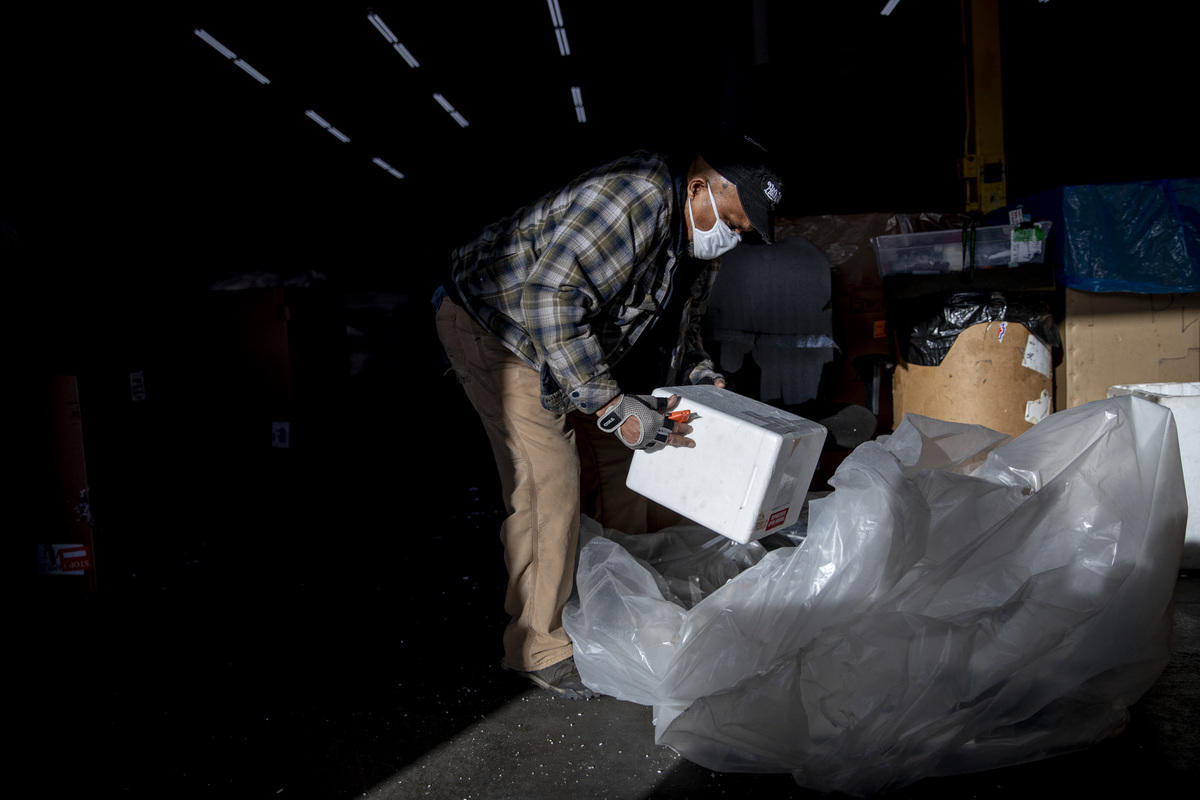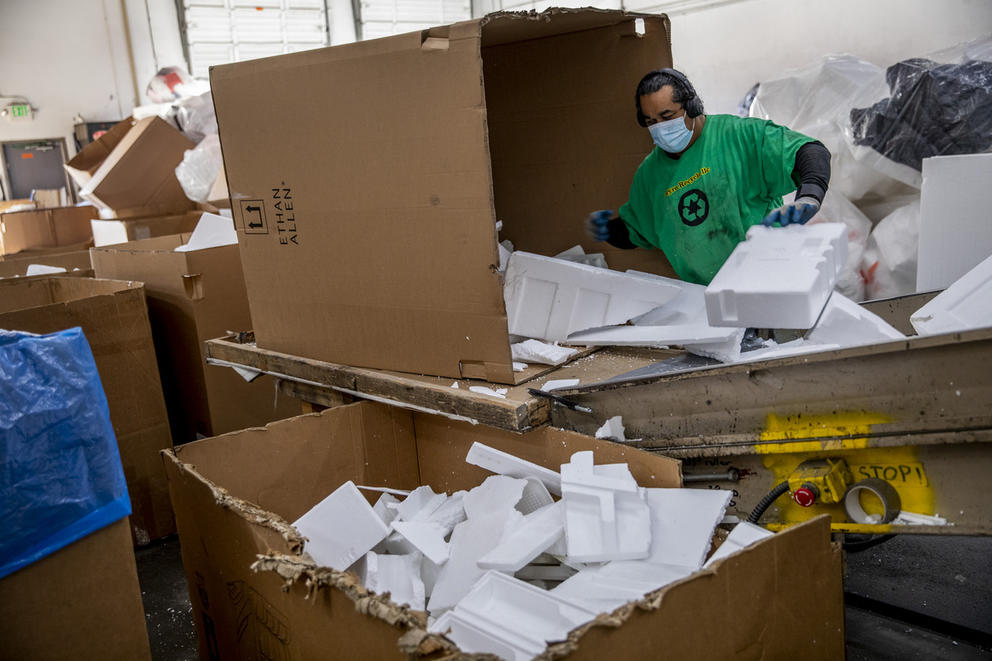That is what it can feel like to have foam packaging in Seattle. The material commonly referred to as “Styrofoam” — but more accurately known as expanded polystyrene, or EPS — has been banned in the city’s food service packaging since 2009. Washington state is currently weighing a new measure, Senate Bill 5022, that would do the same.
Want to know more about the author? Read Samantha Allen's introduction to Crosscut readers.
But stroll down any city street, and you’re bound to find blocks of the stuff filling up dumpsters or poking up over the tops of trash cans.
That’s because Seattle and the rest of the state are throwing out tons of EPS. During the 2019 calendar year, King County recycling manager Jeff Gaisford tells me, about 5,000 tons of EPS ended up in the Cedar Hills Regional Landfill — a small percentage of total annual waste but, by weight, that’s equivalent to roughly 400,000 mountain bikes.
Washington residents threw out 12,890 tons of polystyrene foam packaging in 2017, according to a state Department of Ecology report published last year. That’s about the same weight as two of the large ferries that serve the Bainbridge Island route — and because the material is mostly air, it would occupy an even greater volume.
Once in landfills, EPS takes up space, degrades at a glacial pace and can pollute the groundwater. So why are we throwing out so much EPS packaging? The simple answer is that it’s complicated to get rid of polystyrene in Seattle without it ending up in a landfill.
For the past two weeks, I have been on a (perhaps quixotic) quest to find a fast, free and convenient way to responsibly get rid of rigid polystyrene blocks without leaving the city limits. (I’ve also received over a dozen emails from readers who reached out after I previewed this column in the Crosscut weekly newsletter, so clearly this topic strikes a chord with many of you.)
After speaking with several local agencies, businesses and private recyclers, I still feel as exasperated as Batman on the pier. Here’s what I learned.
As of April 2019, the best way to recycle rigid foam blocks in the city is to put them in clear or white bags and schedule a collection with Seattle Public Utilities online or over the phone. In 2020, a utilities spokesperson says, Seattleites used this free service over 6,800 times, making it their most popular special item collection — but apparently still not popular enough to keep us from landfilling tons of it.
Apart from scheduling a special pickup, options are spotty: Seattle Lighting, which acts a collection point for EPS blocks, temporarily stopped accepting EPS blocks because of COVID-19, but its stores “do plan to be a part of the program when it is up and running again,” employee Nancy Pike assures me. Recology King County also runs special events where you can drop off rigid foam blocks, but those are intermittent. And for a monthly fee, the recycling collection company Ridwell will pick up your foam blocks. Caroline Stanford, vice president of marketing, says Ridwell collected over 850,000 gallons of the material from the Seattle area last year. (That’s enough to fill about one and a half Olympic swimming pools.)
The University of Washington collects polystyrene packaging, too, and notes on its website that 11,971 pounds of it have been processed since 2010. I asked the UW if it accepts EPS foam packaging from Seattle residents, or only from the UW community, but didn’t receive comment by publication time.
You can also take rigid foam blocks to a small handful of places outside of Seattle: the Bow Lake Transfer Station, the Shoreline Transfer Station, which I visited last week or — perhaps the most popular option — Styro Recycle in Kent
Like many readers who emailed me about this topic, Debra Westwood, a retired librarian and Seattle native who now lives on the Eastside, saves up her EPS packaging and “once or twice a year drives a big bag that weighs nothing down to [Styro Recycle] for their free drop-off recycling service.”
People from far and wide make similar pilgrimages to Kent to get rid of their EPS. Marilyn Lauderdale, a former IKEA employee who started Styro Recycle in 2009, says customers have come from “as far as Bellingham and as far as Portland.” Styro Recycle recycled over 800 tons of it last year, using a machine called a thermal densifier to convert it into plastic that gets used in picture frames, crown moldings, outlet covers and more. (Styro Recycle also processes the rigid foam blocks that Seattle Public Utilities and Ridwell collect from Seattle residents.)
But if there’s a place to recycle it nearby, why can’t we throw those big annoying blocks into bins at the North or South Transfer Stations? Becca Fong, residential solid waste outreach manager for Seattle Public Utilities, tells me it’s “not efficient to collect and transport” it from those locations. “Because it is so light and bulky, it takes up a lot of space,” Fong explains. “Space is at a premium at the transfer stations, particularly for materials that cannot be more easily picked up or collected in another way.”
Alternatively, why couldn’t we put them in our blue bins? Hannah Scholes of Waste Management, the company that handles recycling in Seattle, told me it can’t take it because “there’s no stable, long-term recycling demand for polystyrene foam plastic.”
In other words, large-scale municipal recyclers need to know they can reliably find end markets for materials they collect at such high volumes — and EPS just doesn’t qualify.
Which gets to the core of the matter: EPS is a headache. It is light but takes up an immense amount of space. We are receiving way more of it in the mail than we are recycling — last year, only 46 tons of it were taken to the Shoreline and Bow Lake transfer stations — and there aren’t enough market incentives to recycle it at scale anyway.
“People are fed up with it, that’s for sure,” says Heather Trim, executive director of the Zero Waste Washington nonprofit and one of the advocates behind Seattle’s foam food service packaging ban. “It’s fundamentally difficult to recycle, and that’s why it’s something that we want to try to phase out.”
SB 5022, sponsored by state Sen. Mona Das, D-Kent — and supported by Zero Waste Washington — cleared the Washington state Senate on Tuesday. But if passed, it will not ban the rigid foam blocks that have become my sworn enemy over the course of writing this column.
The bill would, however, institute a statewide ban on EPS food service packaging, foam coolers and packing peanuts beginning in 2023. A member of Das’ staff says the measure will “dramatically cut down on the amount of Styrofoam that goes into the solid waste stream or becomes litter.”
But what of the big blocks, which are harder to find alternatives for, and which get more pushback from industry when you try to legislate against them? Market innovation could lead to replacements. IKEA, for example, is introducing a mushroom-based substitute to polystyrene packaging. Future legislation could also set target dates to phase out the blocks.
But until then, a city that prides itself on its sustainability is going to continue putting tons of foam packaging in the trash. And we’ll keep being Batman with the bomb.






